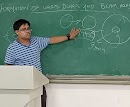Quantum Harmonic Oscillator Part-3: The Asymptotic Solution of Schrödinger’s Equation Quantum Harmonic Oscillator Potential
This article is Part 3 of the article series I wrote about Quantum
Harmonic Oscillator. If you have not read the Part-1: Introduction to Quantum Harmonic Oscillator and Part 2: Schrödinger’s Equation with Dimensionless Terms, then you cannot understand what I am going to explain in this article,
so reading those articles is a must. Also, this article is a bit technical
and a lot more mathematical so, having knowledge of calculus and solution of
equations is a necessary skill to proceed.
Okay, then… let’s start and tame the beast…
In my previous article on Schrödinger’s Equation with Dimensionless
Terms, we concluded with a beautiful equation which is Schrodinger’s
equation with two dimensionless variables (see equation 11 in my part 2
article).
We are going to use that equation here.
Our task is to solve that equation for ψ(ξ) and then
revert the solution to x-space by the substitution,
ξ = αx (1)
We are going to use the asymptotic
method to find a solution in this article. In the next article, we will discuss a
more detailed general series solution for this problem. After that, we will
discuss the characteristics of the wave function in my article on Hermite
Polynomials and Quantum Harmonic Oscillator Wavefunctions.
If you look closely at the equation (11)
of the previous article then you will find that ψ(ξ)
approaches zero as ξ or x
(from equation 1) tends to ±∞. This lead to the formation of the asymptotic form of
ψ. By
this way we can find an expression that gives us the solution for large values
of ξ, that is ξ -->±∞.
The problem then reduces for finding a solution for small values of ξ to be grafted onto the asymptotic solution to
establish a solution that will be valid for all values of ξ. That will be
done in my next article on the series solution.
For now, to establish an asymptotic solution
for ψ, take equation 11 of the last article when ξ is large. By doing
so we will find that only ξ² is large and will dominate,
so that Schrödinger equation
will become like this,
d²ψ / dξ² ~ ξ²ψ (2)
Now, we can postulate a trial solution for the above equation,
ψ(ξ) ~ A exp(βξⁿ) (3)
where, A, β and n are unknowns,
and we have to determine their values.
So, now
differentiating the trial solution, we get,
d²ψ / dξ² = [n² β² ξ²ⁿ⁻² + n(n-1) β ξⁿ⁻²] ψ(ξ) (4)
So, after substituting this solution, equation 4, back to the equation
2, we get,
n² β² ξ²ⁿ⁻² + n(n-1) β ξⁿ⁻² ~ ξ² (5) `
From, equation 3, which is our trial solution we can
see that n must have a positive value as ξ tends to ±∞. So, for a large value of the first term of the left-hand side
will dominate, and in this way we get,
n² β² ξ²ⁿ⁻² ~ ξ² (6)
By comparing, 2n-2 = 2, we get n=2. Also by comparing, n²β² = 1, and since we got n=2, so, 4 β² = 1, and
thus we get β = ±1/2. Before we
pick up the value for β, we have to know what is meant by normalizing. Normalizing a
wave function means that we have to find an exact form which ensures that the
probability that the particle is found somewhere in space is 1. This shows us
that, the particle must be somewhere. This means in technical terms as to solving
for some constant subject to the above constraint that the probability is equal
to 1.
Now, as you know the importance of normalizing, so on the basis
of that we can choose the value of β. Choosing β =+1/2 will be catastrophic
as it would lead to the asymptotic solution of the ψ(ξ) ~ A exp(ξⁿ/2), which
is impossible to normalize. Rather if we choose β =-1/2 then, we can normalize it as something to the
value of negative number will always finite and will not tend to infinity, so
there is always a chance that we get a value. Try it yourself if you don’t
agree!!!
So, in this way we finally
found our Asymptotic solution for SE of QHO potential,
ψ(ξ) ~ A exp(-ξ²/2) (7)
And remember ξ -->±∞.
Equation 7 is the only possible solution to equation 3 which
can satisfy equation 2 or in
other words reduced dimensionless SE equation for QHO potential, when ξ -->±∞. This is only a partial solution as I wrote
earlier, we still have a task left to formulate a generalized equation for the wavefunction. This will be done in the next article.
My next article will be on the series solution for harmonic potential (part-4 of this article series) which will be followed by an article on Hermite Polynomials and Quantum Harmonic
Oscillator Wavefunctions (part-5 of this article series). Once its uploaded, the link
will be uploaded here.
Thanks for Reading!!!
-Ratnadeep Das Choudhury













0 Comments